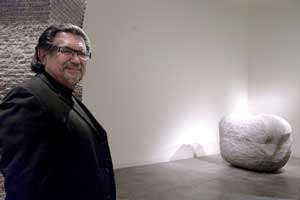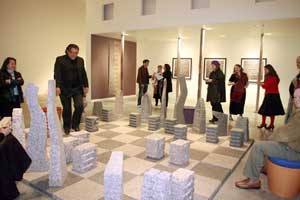Q&A: Jesús Moroles
By Tina Aguilar, ART + SEEK

Photo courtesy of Enrique Cervantes Fernandez
A few years back while exploring place-making with intersections between art and landscape architecture, I experienced a deeper understanding of sculpture through the art of Jesús Moroles. His remarkable ability to combine art and spirit of environment captured my attention and illustrated an ever-prevailing interest about the forces that bind nature and human beings. This month, his exhibition, Creating a Sense of Place, continues at the Latino Cultural Center. I had a chance to visit with him about matters of place, his latest land sculpture and ancient environments. Curator Enrique Fernández Cervantes says that Moroles, “constantly seeks the opportunity to bring together nature and humans to produce a palpable correspondence between them” and proposes that we explore the harmony of Moroles’ mantra to engage with site and form.
Tina Aguilar: In your current exhibit, one encounters whispers with your stone offerings. Temporal and tactile influences enable a visit to a broader landscape that stretches beyond the site walls. How would you describe space with this exhibition?
Jesús Moroles: I actually had a lot of ideas for the space … and had lots of drawings illustrating my work. It comes down to time and money and resources. In my previous show at the Latino Cultural Center, I got to do a lot with the entrances and pieces spread throughout the site. This show was meant to energize the space with some new work while keeping in touch with the intimacy. The entrance totems rotate and can be touched and felt on all sides. Then, as you walk through the passage towards Spirit Fountain, a shift occurs with a larger form. One can travel to the chessboard or back towards Grey Cloud, a piece that in the future may rest on stainless steel legs – I can fit inside its hollow interior. My definition of a good sculpture is that it makes you walk around it. I want people to walk around and engage with the forms.
T.A.: Can you talk to me about the chessboard? I was trying to figure out if one of the pawns succumbed to an en passant move. Are the pieces meant to stay in the current formation? (For all fellow chess aficionados in town, this is a must experience – you can feel your moves.)
 J.M.: No, I did not leave the pieces in any specific spot. When we first started designing the show, I played with the pieces of the chess set as I was in the room. There was a young lady who started to play a game with me, and we kept exchanging fast moves, kind of like in speed chess, then I made one fast move that really counted and she said she had to go. I want people to use the pieces. It doesn’t matter if they move them or if all of them accumulate outside the board.
J.M.: No, I did not leave the pieces in any specific spot. When we first started designing the show, I played with the pieces of the chess set as I was in the room. There was a young lady who started to play a game with me, and we kept exchanging fast moves, kind of like in speed chess, then I made one fast move that really counted and she said she had to go. I want people to use the pieces. It doesn’t matter if they move them or if all of them accumulate outside the board.
T.A.: Your sculptures offer an opportunity to explore literal and internal topographies. Is there one project in particular that you could elaborate on?
J.M.: One recent project is the Joslyn Museum. I designed the front of the museum and created a land sculpture with a reflecting pool, columns and water wall. The idea came to me when I took a tour of the museum. They have these drawings that derive from the history of the Lewis and Clark exploration. This is the first time I have connected my sculpture to anything in a collection. I came up with the idea that this must be a functioning fountain. I created a river design, the Platte River to Sioux Falls, inside the reflecting pool. It actually drains and floods and recedes in cycles, and anyone can get in or out. I was stationed near here when I was in the Airforce, and I know the river and area. In the winter time, this piece becomes a reflection of how nature involves herself when the snow melts. Underneath the reflecting pool there is a design of hot water lines, and in the cold weather – as with thawing – smoke comes off the surface.
T.A.: You perform a ritual with every tear or incision with your forms. There is a new derivation of you stonework called Broken Earth. Can you describe the process?
J.M.: The Broken Earth forms connect to something I have been thinking about for a while. This idea that we as a society are a throw-away culture … only bound to replace objects or cars. Instead of an act to fix things … some people just buy new cars. I remember things like a hair dryer. We used to take the dryer apart and pull out the hair and then sauter the pieces back together to repair it. For my new work this applies. I took the stone apart, tore it apart and then polished certain areas and did certain things to it and put it back together. I added and re-created the form with some of those broken pieces and made it into something that is better, something that nature and man have touched and together.
